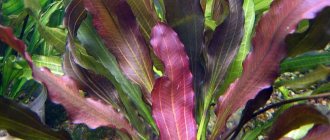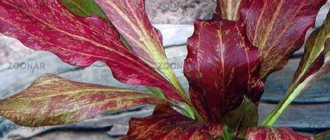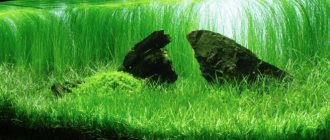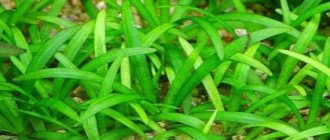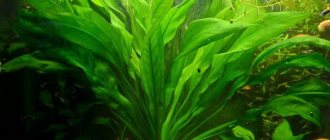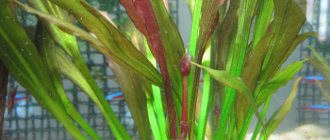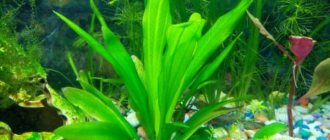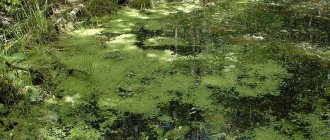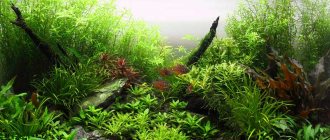Amazonian Echinodorus
The Amazonian species is most popular among experienced and novice aquarists. After all, Amazon has the following advantages:
- Easy care and maintenance.
- This aquarium plant is suitable for planting in tanks that differ in size, volume, and design. They look like bushes, the height of which reaches 40 cm.
- Acceptable temperature range: 16–28 degrees.
- The Amazon endures the blackout. When selecting lighting equipment, you should be guided by what phenotypes are used to fill the containers.
These varieties are planted in an aquarium, the bottom of which is filled with substrate and support. The substrate used includes nutrients and substances. Soil thickness is 4–5 cm. The selection of a suitable option is carried out in a zoological store.
Red Echinodorus
Red Echinodorus has another name - red flame. This species was bred through selection. The height of the ruby reaches 45–50 cm.
The leaves of Echinodorus red are large in size. The shade is red. Sprinkles of red and red-brown color are scattered around the entire perimeter.
Such Echinodorus red are planted near lighting equipment. After all, they develop well in bright light. Lighting equipment for the tanks in which these red plants are planted is equipped with fluorescent lamps.
For the normal development of such vegetation, the following conditions are required:
- Liquid temperature is 23–24 degrees.
- For normal growth, a rigid fluid is required.
- Water changes are performed once every 7–8 days. 25 percent of the fluid is replaced. Only in this case will Echinodorus diseases be excluded.
- Soil, which contains nutrients, is used as a substrate. Periodically, for normal growth, beneficial components must be dissolved.
History of getting into the aquarium
Half a century ago, hydrobotanist from the Czech Republic Karel Ratay described 47 species of plants belonging to this genus, which, based on research, are distributed over a vast American territory: from the central states of the USA to Argentina.
Previously, this species also belonged to Asian plants, but since the 90s of the last century, botanists have determined that the genus Echinodorus still consists of 26 species and several subspecies, living mainly off the coast of the American continent and the Antilles. Later, this plant found its way into aquariums and today is widely used in their flora decoration.
Look how beautiful Echinodorus looks.
Reproduction
Echinodorus blechera reproduces quite quickly and without problems, which is not difficult even for a novice aquarist. Occurs most often vegetatively in an aquarium. Although this can be done by dividing the rhizome. To do this, use a knife with a thin blade to cut off the part where the bud has already appeared, after first pulling out the plant and turning it down with its leaves. Then replant, without burying it completely, but leaving it sticking out a little above the surface of the soil.
In the case of vegetative propagation, the plant throws out a large number of long arrows on the peduncle, which are daughter shoots necessary for further propagation. Moreover, their number does not affect the condition of the mother bush, unlike other plants. It wouldn’t hurt to remove old and weak leaves from it. Breeding should begin when the plant reaches one to one and a half years of age.
And as soon as the first 3-5 leaves and roots appear, the young plant should be planted a little further into the ground. We press the part with the shoot with a small stone, a hairpin or something else that does not dissolve in water, so that the plant takes root and is not pulled out by fish.
It is worth noting that with this form of breeding, Echinodorus blechera develops faster separately from its original bush if it is provided with pieces of clay as additional food
And since the arrow is very fragile, maximum care must be taken when transplanting. If this nevertheless happens, but even smaller shoots remain on it, the fragment can be deposited in a separate tank with a small amount of water, provided with bright lighting and pressed to the bottom with something. Then you will be able to save the shoots, but their growth will be slower
Then you will be able to save the shoots, but their growth will be slower.
Horizontal Echinodorus
Echinodorus aquarium plants of this type got their name due to the fact that their leaves are located at an angle of 90 degrees to the bottom of the tank. Low-growing plants grow up to 25 cm in height, but take up a lot of space.
To plant this vegetation, tanks with a large area are used. They are planted in the center of the container so that they develop normally.
For the normal development of these varieties, the following conditions must be met:
- The water temperature in the aquarium is from 22 to 24 degrees. If plant growth slows down, the temperature drops to 19–20 degrees.
- Optimal hardness is 2–16 units. After all, the horizontal variety develops only in a soft environment.
- Acid – 7 units. If the acidity level is elevated, then dwarf vegetation develops worse.
- To complete the tank, lighting fixtures with fluorescent lamps are used. An acceptable level of performance is 0.5 W per 1–1.2 liters of liquid. Incandescent lamps are used as an additional source. Daylight hours are 11–12 hours.
- Various species are used as substrate. After all, the root system of Echinodorus develops quickly and spreads throughout the entire bottom. For normal development, mineral and nutritional supplements are introduced.
Breeding rules
Echinodorus reproduces vegetatively in two ways:
- Rhizome division. The root system is partially removed from the soil and a part of the root with several leaves is cut off from the parent bush. The planting material obtained in this way is immediately ready for transplanting. If the root cannot be separated from the leaves, it is left to float in water until shoots appear.
- Daughter plants. The bush forms flower arrows, on which whorls of flowers and 2-3 daughter shoots are formed. If you lower the peduncle to the ground of the aquarium, the daughter plants will take root faster. Young individuals are separated and transplanted to a new place after they have formed roots and several leaves.
After a short adaptation, young plants begin to grow quickly.
To bookmarks
Echinodorus big bear
Echinodorus great bear grows naturally in Brazil.
The leaves, which are located under water, reach 10 cm in length and 7 cm in width. They have an elliptical shape and waviness. Their shade is olive green with reddish splashes in the center.
This vegetation requires the following conditions:
- The bottom of the tank is covered with a nutrient substrate. If necessary, fertilizers are selected for echinodorus, which are sold in zoological stores.
- Water parameters: temperature from 22 to 28 degrees, hardness – 5–15 units, acidity – 7 units.
- Containers with such vegetation are equipped with lighting fixtures with fluorescent lamps and incandescent lamps.
- Periodically, fluid changes are performed in tanks with such vegetation (about 25 percent).
Variations of the plant
Echinodorus Grosser Baer - Echinodorus Big Bear. A hybrid plant up to 40 cm high. Appearance of the bushes: long petioles, oblong slightly wavy leaves of olive green and reddish shades. Breeding conditions and maintenance are similar to Echinodorus Kleiner Bar.
Echinodorus argentina
Under natural conditions, Echinodorus Argentine grows up to 0.8–1.2 meters. In aquarium conditions, its height reaches 35 cm. The shape of the leaves is oval.
The color of the leaves is dark green with clear veins. Those leaves that protrude above the water have a light green tint. The peduncle, which includes 16 whorls, is concentrated in the central part.
Echinodorus argentina does not bloom in aquarium conditions. Daughter plants do not grow from the root system.
Echinodorus argentina is easy to keep:
- The bottom of the container is covered with a substrate and nutrient substrate. Fertilizer is periodically introduced into the soil to ensure normal development of vegetation.
- For normal development, powerful lighting equipment is required, which is equipped with fluorescent lamps.
- The back wall of the aquarium is suitable for planting. After all, the vegetation of Argentina reaches significant sizes.
Description and content of Echinodorus species
The Echinodorus family has over 50 varieties, not counting artificial varieties that appeared thanks to the efforts of gardeners. All plant species are divided into three categories according to growth type:
- Growing underwater.
- Floating in the water.
- Growing over water.
Varieties of the family differ from each other in individual requirements for living conditions, appearance and size, so among the abundance of species, every aquarist will be able to choose a plant to his liking.
Amazonian
Amazonian Echinodorus is one of the most famous species of the family, which aquarists enjoy planting. The variety grows up to 40 cm in height and looks like a bush with long light green leaves. Amazon has a simple content and is suitable for decorating aquariums of different sizes and shapes. To prevent the leaves from creeping along the ground, it is better to plant the flower in spacious containers.
The flower is planted in a nutrient substrate, or in a substrate. Soil thickness is 4-5 cm, water temperature is 16-28C. Amazon can withstand changes in water composition and darkening well. For rapid plant growth, you should update the water in the tank weekly, replacing 1/5 of the volume.
Red Echinodorus
Red echinodorus have a second name - fiery flame, which is due to the color - the large leaves of the plant are decorated with splashes of scarlet and rusty shades. The red species was selectively bred; the height of the ruby plant reaches 45-50 cm.
The red variety is planted near fluorescent light bulbs for development, since the plant needs bright light.
Conditions for keeping:
- Water temperature – 23-24C.
- Hardness – high.
- Fluid replacement - weekly 25% volume.
- The soil type is nutritious.
A big bear
The variety called "Echinodorus great bear" is native to Brazil, and stands out from other members of the family with olive leaves with burgundy splashes in the middle. The leaves are 10 cm long, 7 cm wide, and elliptical in shape, making the plant look striking in artificial reservoirs.
To maintain this variety you need:
- Nutritious soil. If necessary, purchase fertilizers for echinodorus if the flower does not want to grow.
- Water parameters: temperature – 22-28C, hardness – 5-15 dH, acidity – 7 pH.
- The type of lighting is intense, which is created using fluorescent lamps.
- Water change - weekly 25% of the volume.
Argentinian
Echinodorus argentina is a tall shrub that in the wild stretches up to 1.2 m. When kept in a home pond, the size of the flower is much smaller - the plant reaches 35 cm. The leaves of the flower are green, oval-shaped, with clear veins. There is a peduncle in the center, but Echinodorus Argentine does not bloom under artificial conditions.
Echinodorus by Igor Filippov
Echinodorus Igor Filippov is a variety that has a second name - sinusoid, due to the characteristic shape of the leaves. The green firefly echinodorus has light green leaves, the shade of which changes as it grows. The height of the flower is 30 cm.
To keep it in the tank you need:
- Replace 30% of fluid volume weekly.
- Water temperature – 24-26C.
- Acidity and hardness are moderate.
- The type of substrate is nutritious; useful fertilizers are regularly added to the soil.
Saint Elmo's Fire
Echinodorus St. Elmo's fire is a plant whose leaves are collected in a dense rosette. The variety prefers to grow in clean water, so to maintain the flower, the aquarium is equipped with a filter and an aerator. Lighting is no less important - a variety called “St. Elmo’s fire” will only develop with high-quality, powerful lighting.
Contents require:
- The soil is silted, the layer thickness is 2-3 cm.
- Water temperature – 22C.
- Installing a good filter.
Supreme Landscaper
One of the most prominent representatives of the family is the supreme landscaper. The leaves of the plant are dense, with clear veins, and bright green. The flower reaches a height of 30 cm. To maintain a supreme gardener, you will need:
- Nutritious soil.
- Spacious and extensive tank.
- Powerful lighting.
The flower is planted in the center of the aquarium, since due to the size and lush bush, the plant will feel uncomfortable in other areas. Only experienced aquarists can reproduce this species at home.
Small-flowered tropica
Echinodorus parviflora tropica is native to Denmark and is popular with experienced aquarists and beginners alike due to its easy maintenance. The representatives are low-growing - the flower stretches up to 12 cm, the leaves are dark green, with corrugated edges.
The small-flowered species is placed in the foreground, as the plant has slow growth and delicate leaves. The content requires the following parameters:
- acidity – 7 pH;
- hardness – 2-15 dH;
- temperature – 22C.
A filter is installed in the tank, the water is changed weekly, updating 25% of the volume. A combination of gravel and sand is laid out as the soil, further fertilizing the soil. The lighting is intense.
Devil's eye
Echinodorus devil's eye is a flower with a mysterious name. The leaves of the plant are boat-shaped, the color is rich green or red, with a brown border along the edges. For keeping at home you need:
- Water temperature – 22-25C.
- Water renewal - weekly 25% of the volume.
- The type of soil is nutritious, with useful minerals.
- Alkalinity and hardness are moderate.
Dancing feather
Echinodorus firefeather is a decorative variety obtained artificially. The flower got its beautiful name thanks to its colorful leaves, shaped like a bird’s feather. The plant reaches a height of 50 cm. To maintain a hybrid version in an aquarium you need:
- Intense lighting in the tank.
- Nutrient soil 2-5 cm thick.
- Spacious vessel with a capacity of 250 liters.
- Installation of aerators and filters in containers.
Bertera
Echinodorus bertera is a plant distinguished by its ability to change appearance as it grows. Young leaves have a lanceolate shape, then acquire an oval shape. Subsequently, a new shape is formed on the petioles - heart-shaped. If the plant continues to live in liquid, then the flower stops growing, maintaining its unchanged appearance.
The following conditions are required for content:
- Temperature – 4-28C.
- Acidity – 4-8 pH.
- Hardness – 0-20 dH.
- The degree of illumination is moderate or strong.
In tanks, Bertera is planted in the center of the tank, or at the back wall, while it is recommended to keep the flower in spacious aquariums.
Echinodorus tender
Echinodorus tender, or dwarf Amazon, is an aquarium underwater flower, which, due to its small size, is planted in the foreground of the tank. The leaves of the plant are elongated and bright green, but in low light the leaves change shade from green to yellow.
Contents require:
- The lighting is intense.
- Temperature – 24-26C.
- Hardness – from 4 dH.
- Soil type – river sand, layer thickness – 2-3 cm.
Echinodorus by Igor Filippov
Echinodorus Igor Filippov are decorative aquarium plants that have a unique appearance. The leaves of these herbs have a sinusoidal shape. That is why you can come across another name - sinusoid.
The hue of a plant such as green firefly echinodorus changes as it grows larger. Small plants have leaves that are soft green in color. Height reaches 30 cm.
For normal development of vegetation it is required:
- Weekly fluid changes in the reservoir (about 30 percent).
- Liquid temperature is from 24 to 26 degrees.
- Acidity and hardness are at an average level.
- The bottom of the container is filled with nutrient substrate. For normal development of the root system, periodic introduction of nutrients is required.
Conditions of detention
The maintenance of Echinodorus vesuvius is not at all difficult, but if the parameters of the aquatic environment are unstable, its appearance can be transformed. It grows into a bush that resembles its ancestor, Echinodorus angustifolia. The branches begin to unwind and straighten, sometimes this is due to the fault of the manufacturer who planted the seeds of the plant poorly.
The plant can be planted in an aquarium of any size; it looks beautiful in the middle and foreground. It is better to plant it not in a new, just neglected aquarium, but in a well-silted bottom. Suitable soil is made from river sand, granite chips or small pebbles. In order for Echinodorus to take root well in the environment, it is necessary to trim its roots by a few centimeters before planting. It is better to mix the soil with boiled peat or charcoal; under such conditions, the roots adapt better.
In Singapore, “Vesuvius” was bred as a heat-loving species, so the water parameters are as follows: temperature 22-27o, water acidity 6.0-7.5 pH, hardness 8-12 dH. Regular tap water, free of chlorine compounds, nitrites and nitrates, is suitable for it.
It is important to plant the plant in an aquarium with fish that live under similar water parameters. It is not recommended to be near plants that float and shade the light. "Vesuvius" is a light-loving plant that serves as an indicator of daylight hours and light entering the tank
If there is not enough light, it begins to straighten upward. Fluorescent lamps with a power of 0.5-0.7 W are suitable for lighting. Aeration and filtration are allowed, but not required - it depends on the needs of aquarium pets and other plants. Additional fertilizers containing iron are desirable; Echinodorus can also receive useful substances from feeding fish, or after updating the water. CO2 saturation required
"Vesuvius" is a light-loving plant that serves as an indicator of daylight hours and light entering the tank. If there is not enough light, it begins to straighten upward. Fluorescent lamps with a power of 0.5-0.7 W are suitable for lighting. Aeration and filtration are allowed, but not required - it depends on the needs of aquarium pets and other plants. Additional fertilizers containing iron are desirable; Echinodorus can also receive useful substances from feeding fish, or after updating the water. CO2 saturation is required.
Breeding:
Propagated by root shoots. Under favorable conditions, it can very quickly form lush thickets. By weeding these thickets from time to time, you get valuable planting material.
and
material. Don't forget to share it with your fellow aquarists. After all, this plant is still rare in our country.
Echinodorus vesuvius is a very ornamental plant. Its thin leaves twisted into a corkscrew look very unusual in any aquarium. A correctly placed bush can visually give the aquarium additional volume and height. Good luck with your design decisions.
Compatibility:
Since Echinodorus vesuvius is light-loving, it should not be placed in the shade of other plants or under thickets of species floating on the surface of the water.
Nutrition: Additional feeding is not needed. There are quite enough nutrients entering the aquarium when feeding the fish and replacing one fifth of the water weekly.
Echinodorus dear Leonid Ilyich
The unique aquarium plant Echinodorus “dear Leonid Ilyich” has an attractive appearance and amazing qualities. Their leaves are characterized by increased rigidity and a certain thickness.
The leaves of adult plants have certain reliefs. Most of the leaves have a brown tint. White veins are distributed along the entire perimeter. The length of the leaves reaches 10 cm. The total height of the plant is 40–45 cm. The leaves dissolve in the middle layer of water.
For normal cultivation the following conditions are required:
- Liquid temperature in the container: from 22 to 25 degrees. Water changes are performed every 7–10 days (about 25 percent).
- A nutrient substrate is placed at the bottom, which promotes the normal development of the root system of the Echinodorus bartera plant.
- Vegetation is located in the central part of the tank so that it develops at a normal level.
Reproduction methods
The plant can be propagated in two ways:
- with the help of daughter shoots growing on peduncles;
- shoots from the rhizome.
A more common method of propagation is by daughter plants on peduncles. At their nodes young specimens with several bright leaves are formed. It is necessary to wait until the shoots form several roots. After this, they are carefully disconnected from the shoot and transplanted into the ground.
Dormant buds form on the rhizome of adult specimens of Echinodorus regina. Sometimes young bushes grow from them. The first shoots quickly form roots and leaves. It will be possible to separate the young plant when the length of the roots and leaves reaches 3-5 cm, and their number is from 5 to 10. This shoot is cut off along with part of the rhizome and transplanted to a separate light area.
After removing the first, most developed, daughter plants, a sharp growth spurt occurs in the remaining shoots. Thus, from one adult plant you can get 2-3 daughter plants several times a year.
To bookmarks
Echinodorus St. Elmo's fire
The St. Elmo's fire plant is planted in containers with purified water. In order to eliminate the accumulation of organic residues and waste products, the tank is equipped with compressors and aeration devices.
For the normal development of St. Elmo's fire plants, powerful lighting equipment is required, which is equipped with fluorescent lamps. After all, whether the plant will develop normally depends on how high-quality the lighting is.
Among the decorative qualities of this plant are:
- The bottom of the aquarium is filled with silted substrate. Its thickness is about 2–3 cm.
- The growth of an aquarium plant does not stop throughout the year.
- The temperature of the liquid in the container is about 22 degrees.
- The container with this plant is equipped with a high-quality filter, which removes all impurities.
Tips for aquarists
- For lighting, you can use fluorescent lamps, LED spotlights or complex panels.
- In order to propagate the plant, you can try dividing the rhizome. This should be done with a sharp knife or scissors.
- It is not recommended to replant the plant earlier than 3 months after it has taken root in the aquarium.
- You can grow plants from seeds. Compressed peat soaked in aquarium water is suitable as a soil. Sowing should be kept in a bright, warm place.
Supreme Landscaper
Among aquarium plants, the supreme gardener deserves special attention. After all, their leaves are distinguished by a bright emerald hue. The leaves are distinguished by increased density and the presence of veins.
The Supreme Landscaper is easy to keep. To fill the bottom, a substrate with nutrients and useful components is used.
For the normal development of the plant, the supreme gardener requires a voluminous tank, which has a large area. The lid of the container must be supplemented with lighting equipment. The duration of daylight hours is 10–12 hours.
The supreme gardener rarely produces the arrows that are necessary for normal propagation.
The height of the supreme gardener plant reaches 25–30 cm. It grows in the form of a bush, so the central part of the aquarium is allocated for its placement.
Echinodorus parviflora tropica
Echinodorus parviflora tropica comes to the shelves of pet stores from Denmark. It is preferred by both beginners and experienced aquarists. This is because there are no problems with the content.
The length of the plant reaches 12 cm in aquarium conditions. The leaves, like all vegetation, are dark green. The edge of the leaf is wavy.
The small-flowered species is planted at the front wall of the tank. After all, it is distinguished by its slow growth and delicate stem.
The following conditions are required for successful maintenance:
- Acidity – 7 units.
- Hardness – from 2 to 15 units.
- Temperature is about 22 degrees.
- The need for a mechanical filter.
- Water changes are performed every 7 days.
- A mixture of gravel and sand is used to fill the bottom. Mineral fertilizers are periodically introduced into the substrate, which promote normal development. After all, they dissolved quickly.
- An aquarium with such vegetation is supplemented with lighting equipment, the power of which is quite high.
What does the Malayan bear eat?
Photo: Malayan bear from the Red Book
Although Malayan bears are considered predators - they hunt small rodents, mice, voles, lizards and birds, they can also be omnivores, since they never disdain carrion and food remains of other larger predators.
Their menu also contains in abundance:
- termites;
- ants;
- bees (wild) and their honey;
- earthworms;
- bird eggs;
- tree fruits;
- edible roots.
From local residents of the regions where these unusual bears live, you can often hear complaints that biruangs severely damage banana plantations, eating tender shoots of banana palms and young bananas, and also that cocoa bean plantations suffer greatly from their frequent raids .
Echinodorus tender
Tenelius is a plant that is popular among experienced aquarists. After all, they are easy to care for:
- Water temperature is 18–30 degrees.
- Hardness – 4 units. Softer liquid is not acceptable.
- In order for each feather to develop normally, the aquarium should be equipped with effective lighting equipment. Daylight hours are about 12 hours.
Vegetation development is slowed down if planted in silty soil. To fill the container, you should use coarse sand, which is supplemented with minerals.
Echinodorus devil's eye
Echinodorus devil's eye is an aquarium plant whose leaves are shaped like boats. The color of the leaves ranges from green to bright red. Their edge is brown.
The color of the leaves does not change over time. The only thing that changes in low light is the fiery frame.
The content requires the following conditions:
- The temperature of the liquid in the aquarium is 22–25 degrees. Water changes are performed every 6–10 days.
- A nutrient substrate with a certain amount of minerals is placed at the bottom of the container.
- Acidity and hardness are at an average level.
Where does the Malayan bear live?
Photo: Biruang, or Malayan bear
Malayan bears live in subtropical and tropical forests, on swampy plains and gentle foothills of the islands of Borneo, Sumatra and Java, on the Indochina Peninsula, in India (northeastern part), Indonesia, Thailand and lead a predominantly solitary lifestyle, with the exception of female bears with cubs and periods when mating occurs.
Echinodorus firefeather
Dancing feather is a fiery aquarium plant that was bred artificially. In order for the dancing feather plant to develop normally, the following conditions must be observed:
- Those tanks that are prepared for the dance plant are equipped with lighting devices with fluorescent lamps.
- A nutrient substrate 2–5 cm thick is placed at the bottom of the aquarium.
- The tank dimensions are about 250–300 liters. After all, the height of the dancing feather plant reaches 50 cm.
Periodically, an aquarium with such vegetation is cleaned using a compressor and a filtration unit.
Echinodorus in the aquarium is an ideal option for beginners and experienced aquarists. After all, caring for them is easy. It is enough to choose the right container and regularly change the water in the container.
Video about the development, reproduction and transplantation of echinodorus
AdminAuthor of the article
Did you like the article?
Share with your friends:
General information
Echinodorus is a genus of plants in the Chastukhov family. Many aquarists place Echinodorus in the aquarium, fascinated by the beauty of the underwater flower. The plant genus includes many varieties, including annuals and perennials, growing above and below water.
Many species of Echinodorus are cultivated, since it is not difficult to grow plants in home artificial reservoirs - the flowers easily adapt and grow in liquids with different indicators. General recommendations for keeping members of the family in an aquarium:
- Bright, intense lighting.
- Clean, clear water, which should not be exposed to direct sunlight.
- Installing a filter and aerator to purify water and saturate the liquid with oxygen.
- Certain species require additional fertilizing with fertilizers.
- Care - aquarium Echinodorus plants are regularly trimmed and overgrown parts are removed.
